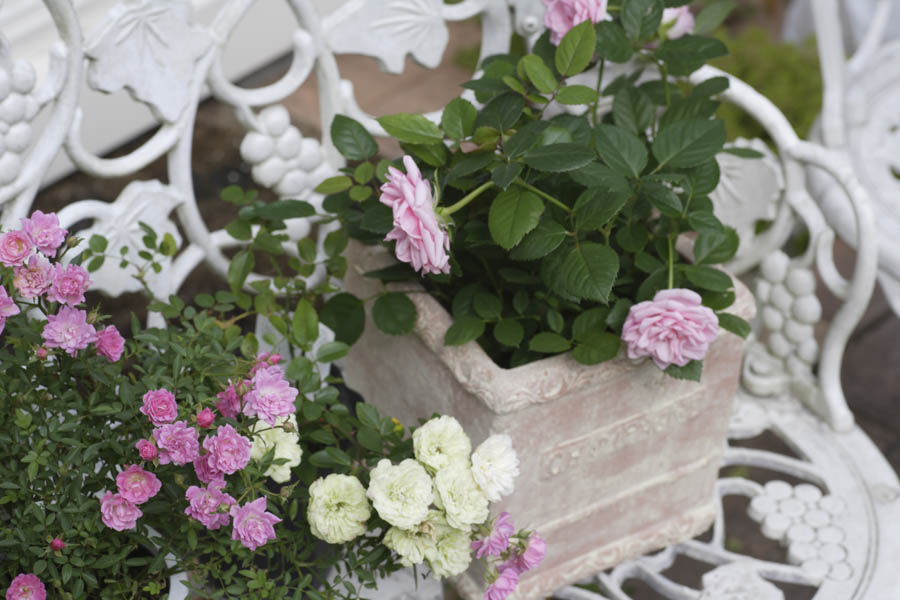Growing Roses in Containers: Common Problems

Beautiful, healthy roses grown in attractive containers can be a beautiful addition to a landscape. However, a number of challenges arise when growing woody perennials, such as roses, in pots or anywhere root space is limited:
1) Root binding: It is inevitable with most potted roses that roots will outgrow the available soil and space. Root binding will cause many roses, and particularly those in smaller pots, to decline within a few to several years as roots circle, girdle, exhaust available nutrients, and become so densely packed inside pots that water and nutrients may not penetrate rate. Root binding is a common cause of stress, disease, pest infestation, and death in potted roses. To keep roses alive and healthy indefinitely in pots, they must be moved to a larger pot with fresh soil about every 2 to 4 years; or removed in about the same time frame and carefully root pruned during a time of year when the plants are dormant or semi-dormant and not blooming, and when weather isn’t hot, then returned to the same pot with fresh, nutrient-rich soil.
2) Salt burn: Minerals are added to most municipal water to prevent corrosion and extend the life of water pipes. When potted trees and plants are watered with city water, such as that coming in through landscape hoses, irrigation systems, or house faucets, some of the water evaporates, leaving minerals behind in the potted soil that tend to build up and become toxic to plants. The damage from this typically appears as dead, brown leaf edges and/or tips, which may extend to cover most or all of a leaf’s surface, and if allowed to persist and worsen, this will eventually kill almost any potted plant or tree. To address salt burn, soil in pots must be flushed periodically to dissolve and remove mineral build-up. This can be accomplished by leaving a potted plant outdoors all day in rain for a few days per year; or by soaking potted plants in fresh water (municipal or otherwise) for a few hours, such as in a large bucket or tub filled with water up to the brim of the pot, then flushed by running water through the potted soil for several minutes. Roses grown in pots under eaves or in areas protected from natural rainfall generally need to be flushed at least twice per year to avoid salt burn.
3) Anaerobic soil: Water becomes trapped in pots with poor drainage, and once oxygen in the water is depleted, anaerobic organisms multiply and produce foul-smelling byproducts that are toxic to plants. This may occur in pots or beneath the soil surface in poorly drained landscapes. Pots should have large holes in the bottoms to allow for good drainage. Drainage may be improved and anaerobic conditions reduced by including gravel in the bottom of containers, especially in deep containers.
4) Soil dryness: Soil in pots may tend to dry quickly, and roses in containers may need much more frequent watering than those planted directly in the ground. Watch for rose leaves curling inward or wilting slightly and be diligent in avoiding significant wilting. Container roses may need daily watering during warm weather, and in some cases even twice a day during heat waves, particularly when in proportionately smaller pots or when their roots are not connected into the larger soil ecosystem in the soil beneath pots.
5) Nutrient exhaustion: The limited volume of soil in pots becomes exhausted and leached over months and years. Maintain surface dressing of compost and amendments under mulch for potted roses, and consider using slow-release organic fertilizers if your potted perennials show nutrient deficiencies.
For complete, customized instructions for growing all types of roses in your area, go to GardenZeus and enter your zip code and then go to roses.